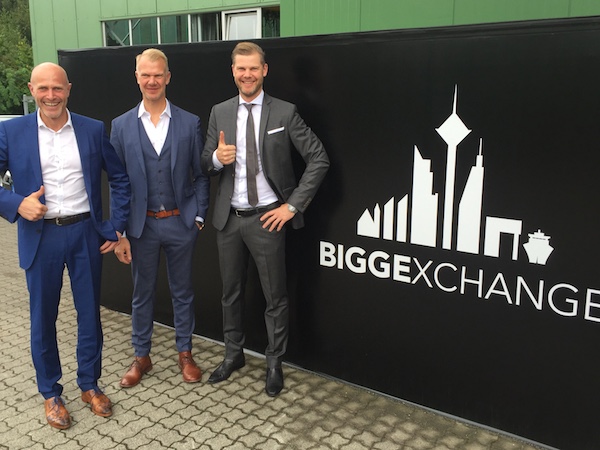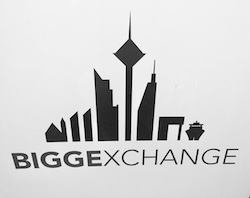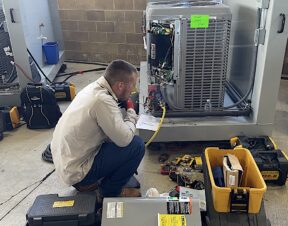Over the past few years, we’ve heard terms such as IoT, Robotics, Artificial Intelligence (AI) when referring to the future of construction, and one speaker in particular, at a plumbing and heating conference recently, scared the hell out of his audience by saying it’s not long now before humans—jobs in particular—will be taken over by “machines” and we should be very worried.
This month’s BIGGEXCHANGE International Symposium had a more level-headed approach to the future of the construction industry. In an effort to seek change and sustainable improvement throughout the construction industry, the two-day event—the brainchild of Dirk Rosenberg, and co-spearheaded by brothers Maik and Christof of Aquatherm—was hosted at the corporate headquarters and manufacturing facility in Attendorn, Germany. “BIGGEXCHANGE is a good brand for social responsibility, sustainability and education,” says Dirk Rosenberg.

The brothers Rosenberg from l to r: Dirk, Maik and Christof.
Named after a nearby lake and the river that flows through the host site, BIGGE is also a play on words to symbolize “Big Buildings and Big Ideas,” and for leaders in the HVAC and construction industry to network and EXCHANGE ideas with fellow industry peers.
 “If we don’t start communicating and build stronger alliances, we will never turn the construction industry into something more positive,” says Dirk Rosenberg, urging more collaboration on the jobsite. Usually, says Rosenberg, trade disciplines all act independently of each other, yet they are working on the same product, which is the building. “Bring people together and start communicating—architects, designers, engineers, contractors, distributors—to form a strong alliance to become successful.”
“If we don’t start communicating and build stronger alliances, we will never turn the construction industry into something more positive,” says Dirk Rosenberg, urging more collaboration on the jobsite. Usually, says Rosenberg, trade disciplines all act independently of each other, yet they are working on the same product, which is the building. “Bring people together and start communicating—architects, designers, engineers, contractors, distributors—to form a strong alliance to become successful.”
BIGGEXCHANGE Takeaways
Addressing some of the myths of the scary AI (and robotics), Matthias Horx posed the question: Is it true that 50% of jobs will disappear? “The future of the construction industry, in an age of digitization, still longs for interpersonal contact, and while trivial tasks may disappear, there will be a boom for human and interpersonal activity,” says Horx, of Zukunftsinstitut GmbH, a think tank to further develop prognostic techniques whose resulting knowledge and potential could be used both in the fields of business and politics. “Every trend has an existing counter trend. We either meet it and disperse, or we meet it and it turns into something greater,” says Horx.

Thought leaders from across the globe convened for the first BIGGEXCHANGE hosted by Aquatherm in Attendorn, Germany.
Presenter Stephen Butler, Autodesk, added, “Jobs in the future won’t be replaced, they will evolve.” By 2020, the robotics industry will create 240,000 jobs, he says.
But Butler’s presentation was more about the emerging trends in building design, with Urbanization and Sustainability—which need to go hand in hand—as focal points. According to the World Bank, says Butler, 9.7 billion people will populate the planet and 6.4 billion of them will be living in urban centers. Currently, commercial buildings consume 40% global energy, 25% global water and 30% greenhouse gas emissions.

Matthias Horx kicked off the event with his Power of Megatrends presentation.
During Dr. Ing. Alexander Rieck’s Future Construction Digital—How Building Will Change in the Digital Age, the topic of the lack of skilled tradespeople in the industry was broached. According to Rieck, digitization will help companies become faster, better and cheaper. “We cannot justify higher salaries to attract skilled labor without digital tools,” says Rieck, Fraunhofer IAO and LAVA.
Further, according to Rieck, the digital revolution will lead to creative architecture.
Piggybacking off of the concept of digitization, professor David Chua Kim Huat, National University of Singapore, emphasized reducing construction times and achieving higher profitability using BIM-based prefabrication in his Design for Manufacture and Assembly with BIM presentation.

The moderator (far left) talks to the panel from l to r: Arab Hoballah; Professor Brian Cody; Julia Goerke, thinkstep AG; Jordan Hardy, CEO, Aquatherm; and Jurgen Hahnrath, Cisco Systems GmbH.
Peter Heinrich, Heinrich GmbH-Communications agency, talked about corporate social responsibility in his “People, Planet, Profit—Sustainable Success with Sustainability and Communication” presentation, which talked about a company’s implementation of social, economic and environmental responsibility to society.
The event’s shift focused on day 2 to sustainable buildings as the highly anticipated Arab Hoballah, leader, SWITCH-ASIA SCP facility/Senior Sustainability Expert, opened with his “Climate Change & Resource Efficiency, the Sustainable Building Engine” presentation and his concern for the children and grandchildren on this planet as a result of climate change through inefficient buildings. “Yet there is optimism through transformative change,” says Hoballah. “We need to be proactive; it is up to us. Mitigating climate change starts with buildings.”

Arab Hoballah, right, is concerned, yet optimistic about the future.
Hoballah’s “urban metabolism” sees buildings similar to our own bodies, with positive impacts based on what is “ingested.” Pointing out the concept of effective circularity, “If we consume efficiently, population growth is not the problem,” says Hoballah. “Increasing consumption and a wasteful society are problems.” And one way to achieve this is through decoupling in manufacturing—a reduction of material intensity in products.
Hoballah ended his talk with four images: sticks, which represent laws; carrots, which represent incentives; tambourines, which represent making noise, understanding legislation and working together; and drums, which represent showing and being proud of your work.

The numbers are eye opening. (Stephen Butler, Autodesk)
Finally, the BIGGEXHCANGE finale featured a roundtable consisting of some of the presenters who gave opinions on the future of construction. “The only constant today is people, and we will continue to make the same mistakes if we don’t change,” says professor Brian Cody, TU Graz. Cody later said that laws and regulations need to change, “My whole life has been going around laws to build green buildings.”
Jurgen Hahnrath, Cisco Systems GmbH, says to stay curious, well informed and don’t be afraid. Jordan Hardy, CEO of Aquatherm North America, echoes the sentiment and says well-informed people and financial interests need to be aligned. Arab Hoballah says that the more we know, the more we move forward. “Behind the curtain there is light. We can do it.”
The Rosenberg’s will continue to push the message in future BIGGE events. “Starting tomorrow we have to put more energy into this to keep connecting,” says Dirk Rosenberg. “This is only the starting point.”

Members of the trade media gather with the Rosenberg brothers.




Join the conversation: